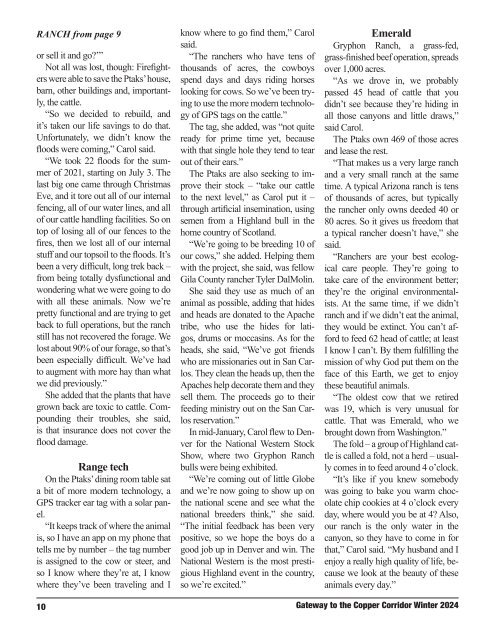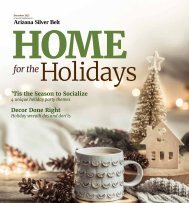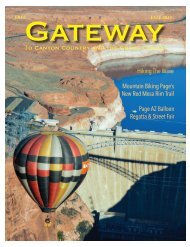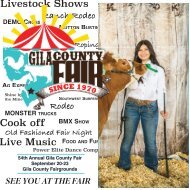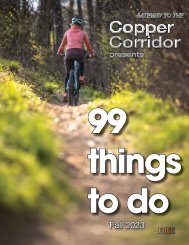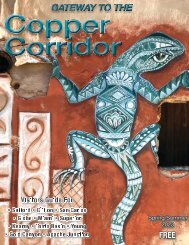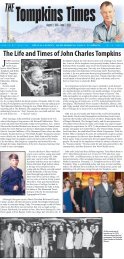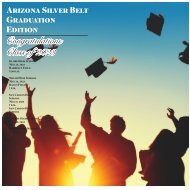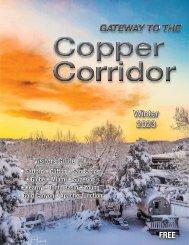You also want an ePaper? Increase the reach of your titles
YUMPU automatically turns print PDFs into web optimized ePapers that Google loves.
RANCH from page 9<br />
or sell it and go?’”<br />
Not all was lost, though: Firefighters<br />
were able to save the Ptaks’ house,<br />
barn, other buildings and, importantly,<br />
the cattle.<br />
“So we decided to rebuild, and<br />
it’s taken our life savings to do that.<br />
Unfortunately, we didn’t know the<br />
floods were coming,” Carol said.<br />
“We took 22 floods for the summer<br />
of 2021, starting on July 3. The<br />
last big one came through Christmas<br />
Eve, and it tore out all of our internal<br />
fencing, all of our water lines, and all<br />
of our cattle handling facilities. So on<br />
top of losing all of our fences to the<br />
fires, then we lost all of our internal<br />
stuff and our topsoil to the floods. It’s<br />
been a very difficult, long trek back –<br />
from being totally dysfunctional and<br />
wondering what we were going to do<br />
with all these animals. Now we’re<br />
pretty functional and are trying to get<br />
back to full operations, but the ranch<br />
still has not recovered the forage. We<br />
lost about 90% of our forage, so that’s<br />
been especially difficult. We’ve had<br />
to augment with more hay than what<br />
we did previously.”<br />
She added that the plants that have<br />
grown back are toxic to cattle. Compounding<br />
their troubles, she said,<br />
is that insurance does not cover the<br />
flood damage.<br />
Range tech<br />
On the Ptaks’ dining room table sat<br />
a bit of more modern technology, a<br />
GPS tracker ear tag with a solar panel.<br />
“It keeps track of where the animal<br />
is, so I have an app on my phone that<br />
tells me by number – the tag number<br />
is assigned to the cow or steer, and<br />
so I know where they’re at, I know<br />
where they’ve been traveling and I<br />
know where to go find them,” Carol<br />
said.<br />
“The ranchers who have tens of<br />
thousands of acres, the cowboys<br />
spend days and days riding horses<br />
looking for cows. So we’ve been trying<br />
to use the more modern technology<br />
of GPS tags on the cattle.”<br />
The tag, she added, was “not quite<br />
ready for prime time yet, because<br />
with that single hole they tend to tear<br />
out of their ears.”<br />
The Ptaks are also seeking to improve<br />
their stock – “take our cattle<br />
to the next level,” as Carol put it –<br />
through artificial insemination, using<br />
semen from a Highland bull in the<br />
home country of Scotland.<br />
“We’re going to be breeding 10 of<br />
our cows,” she added. Helping them<br />
with the project, she said, was fellow<br />
Gila County rancher Tyler DalMolin.<br />
She said they use as much of an<br />
animal as possible, adding that hides<br />
and heads are donated to the Apache<br />
tribe, who use the hides for latigos,<br />
drums or moccasins. As for the<br />
heads, she said, “We’ve got friends<br />
who are missionaries out in San Carlos.<br />
They clean the heads up, then the<br />
Apaches help decorate them and they<br />
sell them. The proceeds go to their<br />
feeding ministry out on the San Carlos<br />
reservation.”<br />
In mid-January, Carol flew to Denver<br />
for the National Western Stock<br />
Show, where two Gryphon Ranch<br />
bulls were being exhibited.<br />
“We’re coming out of little Globe<br />
and we’re now going to show up on<br />
the national scene and see what the<br />
national breeders think,” she said.<br />
“The initial feedback has been very<br />
positive, so we hope the boys do a<br />
good job up in Denver and win. The<br />
National Western is the most prestigious<br />
Highland event in the country,<br />
so we’re excited.”<br />
Emerald<br />
Gryphon Ranch, a grass-fed,<br />
grass-finished beef operation, spreads<br />
over 1,000 acres.<br />
“As we drove in, we probably<br />
passed 45 head of cattle that you<br />
didn’t see because they’re hiding in<br />
all those canyons and little draws,”<br />
said Carol.<br />
The Ptaks own 469 of those acres<br />
and lease the rest.<br />
“That makes us a very large ranch<br />
and a very small ranch at the same<br />
time. A typical Arizona ranch is tens<br />
of thousands of acres, but typically<br />
the rancher only owns deeded 40 or<br />
80 acres. So it gives us freedom that<br />
a typical rancher doesn’t have,” she<br />
said.<br />
“Ranchers are your best ecological<br />
care people. They’re going to<br />
take care of the environment better;<br />
they’re the original environmentalists.<br />
At the same time, if we didn’t<br />
ranch and if we didn’t eat the animal,<br />
they would be extinct. You can’t afford<br />
to feed 62 head of cattle; at least<br />
I know I can’t. By them fulfilling the<br />
mission of why God put them on the<br />
face of this Earth, we get to enjoy<br />
these beautiful animals.<br />
“The oldest cow that we retired<br />
was 19, which is very unusual for<br />
cattle. That was Emerald, who we<br />
brought down from Washington.”<br />
The fold – a group of Highland cattle<br />
is called a fold, not a herd – usually<br />
comes in to feed around 4 o’clock.<br />
“It’s like if you knew somebody<br />
was going to bake you warm chocolate<br />
chip cookies at 4 o’clock every<br />
day, where would you be at 4? Also,<br />
our ranch is the only water in the<br />
canyon, so they have to come in for<br />
that,” Carol said. “My husband and I<br />
enjoy a really high quality of life, because<br />
we look at the beauty of these<br />
animals every day.”<br />
10 <strong>Gateway</strong> to the <strong>Copper</strong> <strong>Corridor</strong> <strong>Winter</strong> <strong>2024</strong>


